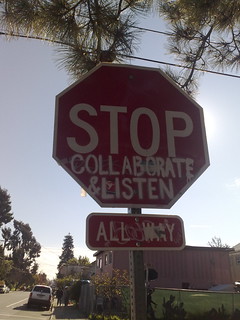For the past few weeks, ChangeEngine’s #SaveBmore campaign has been asking what solutions could transform Baltimore into a thriving place for ALL its citizens rather than the usual tech evangelism or luxury development gospel we usually hear. As much as I’ve enjoyed reading and considering all the posts, here and on Facebook and Twitter, that have been part of the campaign, I had a lot of pause about how to best contribute. Surprisingly, the stumbling block wasn’t the focus of my articles here—art and its measurable impact—but approaching the question at all. What am I attempting to save Baltimore from or for? How do we prioritize the city’s issues with crime, education, its budget? Also, in highlighting some potential solutions, which perspectives aren’t being heard, which problems aren’t being addressed?

Photo by George Kelly via Flickr
I thought then not about how art or creative placemaking can #SaveBmore, but what skills those practitioners have honed that could benefit everyone looking to improve this city and, along with it, the sense of community within Baltimore. One of the things I most respect about creative placemaking is that it’s not about dropping art on an unsuspecting neighborhood or community; it’s about engage groups and listening to them.
To say that a person feels listened to means a lot more than just their ideas get heard. It’s a sign of respect. It makes people feel valued.”
— DEBORAH TANNEN, author and Professor of Linguistics, Georgetown University
With all this in mind, I sent out a request to a group of Baltimore artists who often work collaboratively and whose work I’m familiar with and respect. Specifically, I introduced the idea of #SaveBmore and asked what their work had taught them about listening.
Community Engagement/Empowerment
#Creativeplacemaking = listening to what the community wants = community engagement/ empowerment = great neighborhoods = #SaveBmore
I cannot do this job alone
In order to create exhibitions that are relevant to the communities I am working with, I need to listen. I cannot just listen, I need to collaborate with others in order to implement their ideas to create a meaningful exhibition. Impactful exhibitions allow for that dialogue to continue after the exhibition is over with in order to build stronger and more unified communities. As a curator, I cannot do this job alone.
—MICHELLE GOMEZ, artist, curator
Share wealth resources space information etc
I am struck by the term save bmore. To save means to rescue or protect. It reminds me of colonization when Europeans came into indigenous countries save the savages from themselves. Not. It should be called sharebmore. Share wealth, resources, space, information etc.
There is a divide in bmore between haves and have nots and until we address the real issues of racism, classism, poverty gentrification we are just spinning our wheels with our head in the sand.
—SHEILA GATSKINS, artist
Idealism & vision alone cannot solve the problem
By being involved in the Baltimore theatre scene, I’ve come to realize the beautiful multiplicity of artistic voices this city has. Theatre is also such a wonderful example of collaboration. You need the designers, actors, director, crew and company to all work together, and though it’s a creative process, logistics are KEY (which is why We LOVE Stage Managers). Idealism and vision alone cannot solve the problem. Theatre cannot exist without its audience; so on a larger scale, what sort of Baltimore do we want to “stage” and produce for people to view?
—SARAH WEISSMAN, Marketing Director at Glass Mind Theatre & theatre artist
I love the diversity of opinions and discourse in these responses and know there are more voices out there to be heard; I invite you to comment about your experiences with collaboration and problem solving and what lessons you’ve learned about listening along the way–as well as your overall response or solutions for #SaveBmore.
Additionally, the work of listening is actually hard work, and I don’t recommend it without acknowledging that. We live in a culture that says “The squeaky wheel gets the grease” and applauds action, speaking out and rarely the individual or group who pauses to take things in. It’s a common communication struggle—in collaboration, in the workplace and in our personal relationships—that people are either interrupting or busy thinking about what they want to say next and not actively listening. However, I think we do better when considering these larger issues—if not always—to pause more and persuade less. Listen to what is being said, but also what is unsaid, who is not speaking or present. Improving or even saving Charm City cannot be done alone, as so aptly expressed by Michelle Gomez, and, therefore, requires listening.

RT @miscellaneaarts: New post up on @ChangEngine : http://t.co/6mAXpe0nJ1 Thanks for contributing @Sarahndipity44 @artblocksbmore @Michelle…
RT @miscellaneaarts: New post up on @ChangEngine : http://t.co/6mAXpe0nJ1 Thanks for contributing @Sarahndipity44 @artblocksbmore @Michelle…
RE #Creativeplacemaking, here’s another excellent contribution from @miscellaneaarts via @ChangEngine, http://t.co/GZP0LX7B5S #Baltimore
RT @ARTblocksbmore: RE #Creativeplacemaking, here’s another excellent contribution from @miscellaneaarts via @ChangEngine, http://t.co/GZP0…
RT @ARTblocksbmore: RE #Creativeplacemaking, here’s another excellent contribution from @miscellaneaarts via @ChangEngine, http://t.co/GZP0…
@PPS_Placemaking, check out this excellent take on #placemaking from @miscellaneaarts via @ChangEngine http://t.co/GZP0LX7B5S #Placemaking
RT @ARTblocksbmore: RE #Creativeplacemaking, here’s another excellent contribution from @miscellaneaarts via @ChangEngine, http://t.co/GZP0…